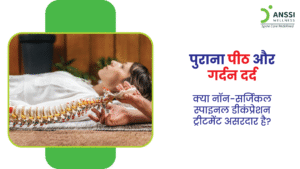The cervical spine gives support for the weight of the head and surrounds & safeguards the spinal cord, facilitating a variety of head movements. Through this blog, we will provide a comprehensive overview of the cervical spine including what is the cervical spine, cervical spine diseases and cervical spine disease treatment.
What is the cervical spine?
The cervical spine basically comprises the neck region of the spine and includes the 7 bones named C1-C7 vertebrae. These vertebrae are isolated from each other by the intervertebral discs, which enable the spine to move readily. They play the role of shock absorbers during movement.
What does the cervical spine do?
The cervical spine conducts various functions such as:
Protecting your spinal cord
The spinal cord nerves navigate a big hole which traverses the centre of all the vertebrae, from the cervical vertebrae, going through the middle back vertebrae and ending between the 1st & 2nd lower back vertebrae. As a whole, all the vertebrae of the spine constitute a shielding central canal which protects the spinal cord.
Supporting your head and allowing movement
The cervical spine acts as a fulcrum for the weight of the head and enables the head & neck to lean in a forward motion, backward motion, side-to-side turning motion or motion that includes tilting to a particular side.
Providing a safe passageway for vertebral arteries
The tiny holes present in the C1-C6 cervical spine vertebrae offer a safe passage for vertebral arteries to transport blood to the brain. This area is the sole vertebrae section in the whole spine that comprises holes in the bone to enable arteries to travel across.
What diseases and disorders affect your cervical spine?
Following are the various disorders that can affect the cervical spine:
Cervical radiculopathy
Comprising symptoms such as numbness, weakness, tingling & pain, this condition occurs in the situation when a cervical nerve gets pinched by cervical vertebrae. The symptoms could stay within the spine region or may spread to the whole arm, hand & fingers.
Neck pain
A common condition that may arise due to a variety of different reasons, neck pain related to the spine could be caused by degenerative conditions like spinal stenosis, herniated disk, osteoarthritis, or a pinched nerve.
Other conditions that may cause neck pain comprise incorrect posture, rheumatoid arthritis, physical strain, mental stress, meningitis, growths of tumors, cysts or bone spurs & cancer.
Cervical degenerative disk disease
This condition arises when the disks constituting the cervical spine wear down.
Herniated disk
A herniated disk is basically a leak/tear to the disks that supply a cushion between vertebrae.
Bone spurs in your cervical spine
Growths that happen on any of the 7 vertebrae in the cervical spine are called bone spurs.
Cervical spondylosis
Also referred to as neck arthritis, cervical spondylosis is an age-linked condition wherein gradual degeneration of the disks & joints in the cervical spine occurs.
Cervical spinal cord injury
When an injury occurs to the cervical vertebrae, it’s called a cervical spinal cord injury. The majority of these injuries are caused by an abrupt, painful blow to the vertebrae.
Cervical spinal fracture
Cervical spine fractures can be caused due to a wide array of reasons. This includes compression (generally due to mild trauma in an individual with osteoporosis) or fracture-dislocation (usually caused by vehicle accidents or falls from steep heights), or a burst fracture (vertebra smashed in all directions).
Cervical spinal cord compression
This condition comprises pressure on the spinal cord in the cervical region of the spine. It’s generally caused due to osteoarthritis (wear & tear on the spine’s bones).
Cervical stenosis
Cervical stenosis is usually a result of ageing and happens when the spinal canal gets narrowed and compresses the spinal cord. It results in the shrinking of space between vertebrae and the discs relinquishing their shock absorption capacity.
Cervical spinal tumour and cancer
Cervical spinal tumours can be benign or cancerous and are essentially abnormal tissue growth inside the spinal column.
How are cervical spine health issues treated?
Depending on the severity of the cervical spine health issue, it can be treated via non-surgical treatment options such as Spinal Decompression Treatment, medications, injections, physical therapy combined with bed rest, etc., or surgery.
Spinal Decompression Treatment for spine health issues
The Non-Surgical Spinal Decompression Treatment is a USA Patented Technology made available in India by ANSSI Wellness Centre. This state-of-the-art technology helps treat a variety of spinal disorders without any surgery.
The treatment has a greater than 85% success rate and provides lifelong pain relief at a fraction of the surgery expenses!
ANSSI has so far successfully treated spinal disorders in 3500+ patients across India, South Africa, Iran, Sri Lanka, Maldives, Tanzania & Canada.
Conclusion
The Spinal Decompression Treatment is the best and highly affordable treatment option for chronic cervical spine issues. If you are suffering from a spine-related disorder, then get in touch with the Spine Specialists at ANSSI Wellness Centre to know more about this treatment.



